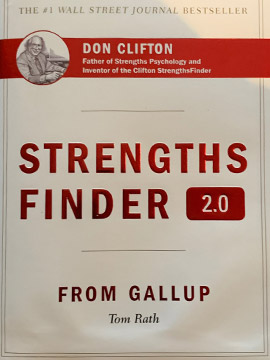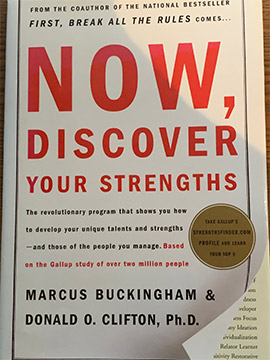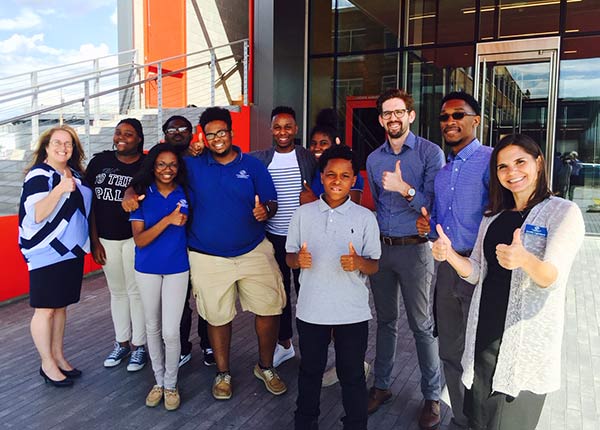Have you ever had that out of the blue experience where spontaneously you start thinking about something complex and suddenly a light bulb goes off. For whatever reason, you see the same thing but in a different way and you begin making connections you had never done before. Personally, I have a better grasp of this today having recently spent some time revisiting Gallup’s StrengthsFinders work in more depth.
Gallup’s decades of research about a persons’ innate talents has resulted in a useful personal assessment tool that identifies 34 distinct themes/ talents The odds of someone else sharing your top five themes in the identical order according to Gallup is one in 288,000. For each theme Gallup provides a vivid description as well as related “Ideas for Action”. In 2004 they branded their core assessment instrument already used by 10,000,000 plus people around the world, “Clifton StrengthsFinders”. The last paragraph of this piece lists the 34 innate talent/themes.
 I’m well aware that TIME IS A SCARCE COMMODITY these days. So if Gallup’s Strenthfinders is of interest to you know you do not need to read anything further here- just purchase Tom Rath’s book, “Strengths Finder 2.0” readily available on line thru Amazon, Walmart, and Barnes & Noble. Then use the code in the book to take the online assessment which will require about 30 minutes. You’ll then immediately learn about your top five innate talents. My prediction is you will be amazed the degree to which Gallup’s Clifton StrengthsFinder assessment nails you.
I’m well aware that TIME IS A SCARCE COMMODITY these days. So if Gallup’s Strenthfinders is of interest to you know you do not need to read anything further here- just purchase Tom Rath’s book, “Strengths Finder 2.0” readily available on line thru Amazon, Walmart, and Barnes & Noble. Then use the code in the book to take the online assessment which will require about 30 minutes. You’ll then immediately learn about your top five innate talents. My prediction is you will be amazed the degree to which Gallup’s Clifton StrengthsFinder assessment nails you.
When I took the Clifton Strengths Finders assessment years ago the second of my top five innate talent themes was “Ideation”. Gallup’s first sentences for the Ideation theme is: “You are fascinated by ideas. You are delighted when you discover beneath the complex surface an elegantly simple concept to explain why things are the way they are. An idea is a connection. Yours is a mind that is always looking for connections.” In Gallup’s Ideas for Action section for someone with the Ideation talent they write: “You are likely to get bored quickly, so make small changes in your home or work life. Finish your thoughts and ideas before communicating them. Lacking your Ideation talents others may not be able to ‘join the dots’ of an interesting but incomplete idea and might dismiss it”. For me these are good suggestions. Though I think I am a good communicator I know my friends, if asked, would say “it takes him awhile to get to the point.”
Having experience running businesses and being a Board member of a variety of non-profit organizations I can say with confidence that Gallup’s Strengthsfinders work is truly helpful to those interested in understanding themselves and others better. It is a useful tool in deepening relationships; Leaders, managers, supervisors, and ad hoc team leaders in a work setting using Gallup’ Strengthsfinders work will get better results.
SOME BACKGROUND RE THE ABOVE & “NOW, DISCOVER YOUR STRENGTHS”
 I first learned about Gallup’s work initially years back when I was a health club owner. At one of the International Health, Racquet & Sportsclubs Association’s national conventions I heard a Keynote speech by a charming Brit, Marcus Buckingham. Buckingham had been a Senior Vice President of the Gallup organization. In 2001 he collaborated with Gallup’s Chairman and the “Father of Strengths Psychology, Don Clifton, PhD. and they wrote the groundbreaking book, “Now, Discover Your Strengths”. Clifton strongly believed that individuals and organizations fared far better by focusing on a person’s natural talent. He and his company, Gallup, had done extensive research to support this strong belief. Buckingham’s talk, this book, and the fact that Gallup had done decades of research focused on finding the characteristics of the most productive employees and organizations around the world caught my attention and caused me to take the Clifton Strengthsfinders assessment for the first time.
I first learned about Gallup’s work initially years back when I was a health club owner. At one of the International Health, Racquet & Sportsclubs Association’s national conventions I heard a Keynote speech by a charming Brit, Marcus Buckingham. Buckingham had been a Senior Vice President of the Gallup organization. In 2001 he collaborated with Gallup’s Chairman and the “Father of Strengths Psychology, Don Clifton, PhD. and they wrote the groundbreaking book, “Now, Discover Your Strengths”. Clifton strongly believed that individuals and organizations fared far better by focusing on a person’s natural talent. He and his company, Gallup, had done extensive research to support this strong belief. Buckingham’s talk, this book, and the fact that Gallup had done decades of research focused on finding the characteristics of the most productive employees and organizations around the world caught my attention and caused me to take the Clifton Strengthsfinders assessment for the first time.
The fundamental thesis of the book is that organizations whose employees feel they get to use their innate talents every day perform better: These organizations had significantly less turnover (50%); more likely to work in more productive business units (38%); and more likely to work in business units with higher customer satisfaction scores (44%). These findings were based on survey questions of 198,000 employees working in 7,939 business units, within 36 companies and made sense to me. Individuals can do better when more aware of their innate natural talents. Likewise, in work settings folk who work together in teams and are tuned into their colleagues’ natural talent themes perform better.
I first used the Strengthfinders Assessment as a management tool when I was consulting for the Pike Creek Fitness Club in Delaware in 2003. When I introduced it to fifteen managers and supervisors to say there was skepticism would be an understatement. However, a week later after the fifteen had received the results of their personal assessment, when I asked the same group: “Please raise your hand if you think the assessment “nailed you” thirteen of the fifteen raised their hands without hesitation.
One of the persons who did not raise their hand said she didn’t like her top five themes. I told her the themes were not good or bad but rather simply an identification of her inherent innate talents.
GALLUP’S Q12 EMPLOYEE ENGAGEMENT SURVEY
Some years later at the Hockessin Athletic Club, in addition to the StrengthsFinders assessment, we also took advantage of Gallup’s Q12 employee survey. This is a useful measure of employee engagement. Each of the twelve employee survey questions is scaled 1 – 5. To get a sense of these, here are three: I know what is expected of me at work. I have the materials I need to do my work right. At work, I have the opportunity to do what I do best every day. As with Clifton StrengthsFinders, you can learn a lot about the content, usefulness, and validity of Q12 by going to the web. At Hockessin we found it a useful management tool re levels of staff satisfaction and the current status of staff areas where we saw opportunities for growth or had concerns.
USING THE CLIFTON STRENGTHSFINDERS ASSESSMENT AT A BOYS & GIRLS CLUB
After retiring, I became a more active volunteer for local Boys and Girls Clubs. In 2016 at the Boys & Girls Clubs of Anne Arundel County, Md. we used Gallup’s StrengthsFinders assessment with a group of Junior Staff that also included some club members who were teens. Once each participant received the results of their assessment, we held a group training and discussion session about the results. Each participant spoke about whether they thought their assessment had gotten them right. Then group members chimed in with comments about a particular participant’s top five talents and what surprised them and what did not re the results just shared. In trusting groups this is a terrific vehicle for opening up new dialogues and new ways of looking at things. Leaving the club after the group session was over, I vividly recall a young male staff member stopping me to say he was newly married and learned some new things about himself that would be helpful in his marriage.

Lisa Mondoro, CEO of the Boys & Girls Clubs of Anne Arundel
County (far left) with Club Members on an Under Armour tour.
The CEO of the organization, Lisa Mondoro, later told me that participants considered it their most interesting and useful training of the year. While Lisa’s comment was both uplifting and appreciated, I cannot stress enough that this early stage of learning about Strengthsfinders and the five top talent themes identified is the easy part. It is fun to see if you think the results nailed you a lot or barley; interesting to see if you find the sentences Gallup has carefully articulated for each of your top five themes on target or not, or if Gallup’s related plan for action recommendations pragmatically helpful for you.
Most participants find considerable value when their assessment is discussed in a group setting with co-workers present. One obtains new insights and in some cases these can prove game changing. This is Stage One (my phrase, not Gallup’s) of a process and is relatively easy to make happen. Stage Two is far more difficult: articulating specifically what you might do differently going forward because of insights obtained and acting on them. Stage Three is even more challenging: using the StrengthsFinders results to set specific measurable objectives for the work unit or Department.
AN IMPORTANT QUESTION THAT INTERESTS ME RE THE BOYS & GIRLS CLUBS OF AMERICA:
Can Gallup’s StrengthFinders be a significant tool for some of the 4600 Boys & Girls Clubs across the United States to attract many more mentors for their members?
To get a better handle on whether this a pie in the sky idea or something that might be possible I contacted Gallup. Although I had used Gallup’s Strengthfinders and Q12 tools previously I have never been to a Gallup training or spent anytime talking to the folk at Gallup. I wanted to speak with someone at Gallup’s office in DC- an hour from our home- face to face about this question. So, I cold called their Executive Director of Education Research, Stephanie Marken, who was based there. I did not reach her and left a message. A day or two later I received a call from a Gallup employee in their Chicago office, John Clark. John was new to Gallup but told me to check out a mentoring program based in Lincoln, Nebraska, TEAMMATES MENTORING. I did and frankly was blown away by what I learned.
In 2019 TEAMMATES MENTORING had 10,000 mentors working one on one with 10,000 students once a week at 190 schools in five states– remarkable numbers for a mentoring organization. It turns out that in 1991 the famed Nebraska football coach, Tom Osborne, Founded TEAMMATES MENTORING in Lincoln, Nebraska. One of Osborne’s professors at the University was Don Clifton. Clifton and Osborne became close friends and undoubtedly that friendship and their mutual believe in focusing on an individuals’ strengths not weaknesses was a factor in the development of a unique partnership between Gallup and TEAMMATES.
I spoke at considerable length with TEAMMATES Training and Match Support Coordinator, Allyson Horne. Allyson is a certified Gallup trainer and passionate about the benefits of using StrengthFinders as a component of programs focused on youth development. TEAMMATES uses Gallup’s Strengthfinders as a vehicle to enhance engagement between the mentor and the mentee. The StrengthsfFinders assessment and related training is made available to the mentors and their mentees. About a third of the mentors use it. Some of the parents of the mentees got interested and also did Gallup’s online assessment. Allyson said parents report that after they have taken the assessment and talked it about with family their parenting skills were enhanced.
Certainly I have better handle now on the potential and value of using StrengthFinders in a Boys & Girls Club setting. We need to further explore whether it is worth the effort to undertake a few small pilot StrengthsFinder projects. I have more confidence that a small pilot project in a few clubs with the right leadership and location at the field level is worth exploration. However, if this concept goes any further we need to be realistic about the infrastructure and partners required to make it work and to sustain the effort over time. Staff at the club level already have a lot on their plate. I personally committed to learning more about what it would take to initiate a StrengthFinders pilot at one or more of our clubs.

